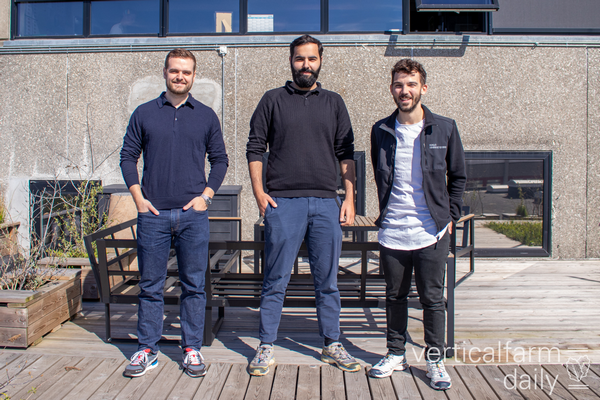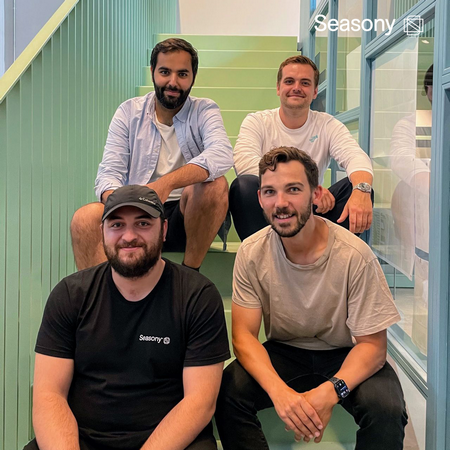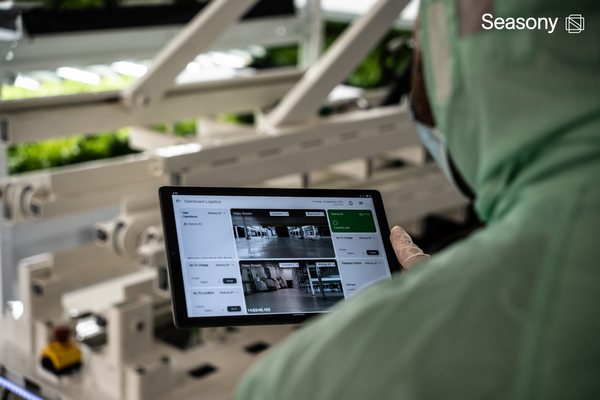“Vertical farming is moving towards an inflection point. From expensive and niche technology towards market leadership from both a commercial and sustainability standpoint. Our vision at Seasony is to make that inflection point come sooner – making vertical farms more scalable, profitable, and sustainable,” Christopher Weis Thomasen, CEO and co-founder of Seasony, begins.
The Danish robotics company Seasony, based in Copenhagen, Denmark, has developed the autonomous mobile robot “Watney” to solve the specific challenges in indoor and vertical farming.

Christopher Weis Thomasen, Erkan Tosti, and Dan Nielsen are pictured outside at their Copenhagen office.
The birth of Watney
Dan Nielsen, head of strategy at Seasony, breaks down the functionality of Watney, “In essence, Watney is a robotics automation platform that brings together three things for our farm customers – automate transportation tasks, gather and visualize climate and visual data, and lastly bring an ecosystem of technology partners to add new specialized functionality.”
“From day one, we focused on the specific needs of our Vertical farm customers. Watney is just 80 cm wide to allow access to racks inside narrow aisles. We use advanced LIDAR technology to allow the robot to navigate in very little space and safely between equipment and people. We designed for a high IP rating so the robot works even in the high-humidity environment of farms. Lastly, we set out a different path with our business model – offering Watney on a full OPEX ‘Robot-as-a-service’ model to reduce the investment need in an already CAPEX-heavy setup,” say Erkan Tosti Taskiran, COO and co-founder.

Watney in action
Reimagining logistics automation in vertical farms
The team tells us how the robot automates repetitive transportation tasks. Reaching up to 10 meters high, it replaces the need for scissor lifts, expensive elevators, and conveyor systems to transport trays and plants from and to racks and stations.
“We can save vertical farms between 30-65% in transportation costs, either by automating repetitive and dangerous human tasks or by removing the need to invest and maintain capital-intensive conventional automation systems,” says Dan.
He continues, “We see ourselves as an especially interesting alternative to conventional automation. Beyond the cost, elevators and conveyors take up space that could otherwise be used for growing crops. For example, a 1.5m wide elevator on a 25 m rack decreases potential growing area and output by ~5%.”

Another team photo, now with Server, CTO and co-founder, in the left bottom included as well
The power of data in vertical farms
“What we do is combine the mobility of the robot with powerful data capture and analytics to take the guesswork out of plant health for our customers.” Christopher starts.
New data offerings are a key part of the product roadmap for Seasony in the coming years.
“We currently have onboard climate sensors measuring Co2, humidity, and temperature. Beyond replacing the need for fixed sensors, moving the robot around the farm enable us to create a very granular 3D climate map of the farm, enabling our customers to pinpoint exact issues and deal with them”, Dan says and continues, “That is only the start, however. This year we will launch a ‘robot crop-walk’ where an onboard camera captures image data of plants for visual inspection. We are also working on computer vision, advanced data models, and so much more in the coming years.”
The opportunity is big, according to the team, as Christopher explains, “It all comes down to how much you can reduce your losses and increase your yield. For a 2000m2 farm, a just 1% increase in yield will provide an additional 71.000 EUR a year in added revenue and reduced costs for crop walks using a robotics solution.”

An open ecosystem for innovation
Seasony is building an ecosystem of technology partners, enabling new use cases. The team showed us examples of cases from advanced analytics, specialized cameras, and harvesting.
Dan details a few applications: “We have two partners we especially like to bring up. First is Gardin, an advanced phenotyping sensor and analytics tool. Combining Watney and Gardin allows us to bring the sensor to all plants creating a full site view of plant health. Second is Organifarms which has developed autonomous strawberry harvesting arms for greenhouses. We are currently working to integrate that to Watney to bring an autonomous harvest of strawberries to Vertical farms.”
Erkan ends by saying: “Opportunities are endless. We have many discussions where customers want to develop an extension for Watney themselves that we then integrate into the mobile platform.”
The future view
“We believe we are in a third wave of vertical farms. It started with manual farms when the technology emerged to the recent second wave of ‘over-automation,’ where millions of venture capital euros were invested in fully automated systems. Recent events have shown the answer is probably a semi-automated system combining the best of automation and the best of people. That is the third wave and where mobile robotics will win the day,” says Dan.
Christopher is excited to leverage their technology to other markets in the future, such as mushroom farming, cannabis growers, and insect farms. “All knowledge and data gathered in vertical farming can be used for other verticals.” This year, Seasony is expecting to deliver 10 robots and plans to scale up production during 2024.
The focus remains on Northern Europe, but the company has eyes on the Middle East, the US, and Canada in the coming years.
Seasony is launching the next iteration of the Watney robot later this year, with increased motor power, more battery life, and a number of other upgrades.
 For more information:
For more information:
Erkan Tosti Taskiran, COO and co-founder
eta@seasony.dk
Christopher Weis Thomasen, CEO and co-founder
cht@seasony.dk
Dan Nilsen, Head of Strategy
dni@seasony.dk
Seasony
info@seasony.dk
www.seasony.dk
